You can also be interested in these:
- Nvidia GTX 1650 vs RTX 3050 graphic cards
- Nvidia GTX 980 vs 1070 Full GPU Comparison
- NVIDIA GeForce GT 720 review
- NVIDIA GeForce GTX 1050 Ti Max-Q review
When we have the chance to read a GPU comparison, being one product a more advanced version of the other within the same series, the most logical thing that comes to mind is that the latest model is always better. It is clear this paradigm is not applicable in all cases, and it is precisely the same when we compare the Nvidia RTX 3090 vs RTX 3090 Ti. In this article we will see an interesting and insightful comparison between the two top GPUs from Nvidia.
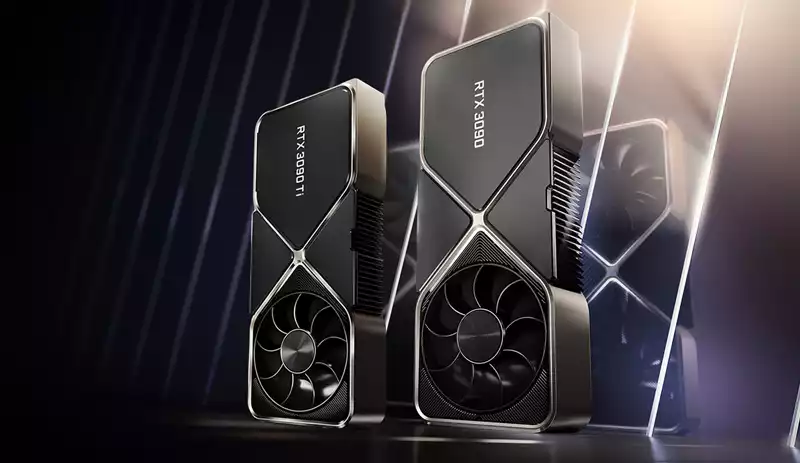
The release of the Nvidia RTX 3080 Ti shook the GPU market with all its innovations and raised the bar for features and graphics display performance quite a bit. Further down the road, the company launches its new model, the RTX 3090 Ti, which promises to be the holy grail of the line, or is it really?
Technical specifications
Being about a new release, we might think it has a smaller die size, greater VRAM memory and memory bus capacity. However, the improvements introduced by the Nvidia RTX 3090 Ti are quite questionable, and an assault to our wallet. In short, these are the “improvements” of the new “Ti” model:
- On purpose, we are going to mention the additional 100 Watts of consumption first.
- Physical changes to the case (suggesting it’s a transition model for the RTX 4090).
- Slight increase in bandwidth from 936.2 GB/s to 1008 GB/s.
- Increased memory speed, from 19.5 Gbps to 21 Gbps
- Increased CUDA Cores (256 more), Tensor Cores (8 more) and RT Cores (2 more).
- Base frequency increased from 1395 MHz to 1560 MHz
- Now you need a stronger power supply.
- Added a 12-pin PCIe connector.
- Absurd price difference ($500 USD more).
Of these points, we have a modest increase in performance and a price that does not justify the improvements. The latter is a factor that, at a glance, leaves us quite at a disadvantage when we evaluate the Nvidia RTX 3090 vs RTX 3090 Ti. The value proposition of the Nvidia RTX 3090 Ti is losing traction. Now let’s see if the performance justifies its price.
Performance
In short, the Nvidia RTX 3090 Ti is faster than its predecessor, the RTX 3090, the question is how fast. Now let’s see the performance tests between these two GPUs, both in 3D and in video games, in the different resolutions.
Ray Tracing results
Before showing the performance comparisons, we have to highlight that not all video games are optimized in the same way to lighten the workload on the GPU. It is for this reason that we have to make some important notes:
- Battlefield V: This game was released in 2018 and its design is not very well optimized for good graphics processing performance. If we do not take this detail into account, we could see biased information. Nonetheless, both GPU models will have the same inaccuracies, and we will be only looking at the difference in performance.
- COD Modern Warfare: Contrary to the previous point, this game is one of the most flexible and best optimized in graphical output. The data obtained in this game will always be better than in any other.
- All games: Ray Tracing values were tested at their maximum values, in all games DLSS and DirectX 12 were used (Except for Wolfenstein Youngblood which was Vulkan).
- All results are measured in Frames per Second (FPS).

In the 1080p performance comparison we go from seeing a difference of 14 FPS in the case of Tomb Raider to only 4 FPS difference in Metro Exodus.

Anyone would expect to see equal differences in the same games, but here we see something curious. At 1440p Wolfenstein, COD and Battlefield V show the biggest differences. In all other cases we see differences not so far away from the average.
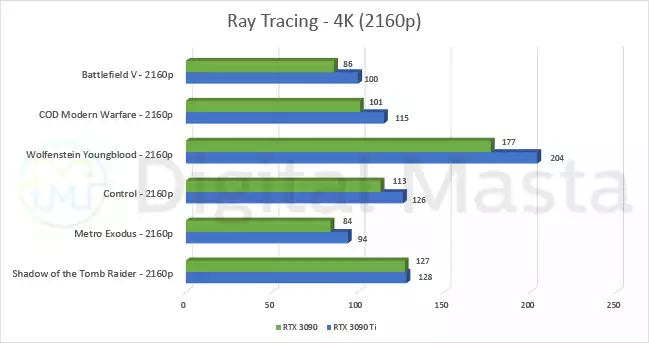
At 4K we start to see how the performance on both video cards drops considerably. Even so, the averages in the differences remain.

Finally, in 8K we see how Tomb Raider takes a leap in performance and substantially moves away from the Nvidia RTX 3090. It should be noted that in this resolution the FPS that the Nvidia RTX 3090 vs RTX 3090 Ti gives us are not at all the appropriate for gaming. These values are incredibly low and the gaming experience is greatly impacted. We have included 8K resolution for testing purposes only.
Gameplay without Ray Tracing
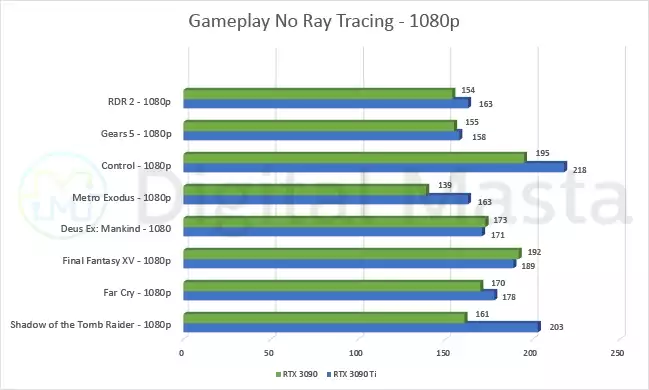
The most significant differences in 1080p we see in Tomb Raider with more than 40 FPS, Metro Exodus with almost 30 FPS and Control with 20 FPS. If these results were consistent across all games, this fact alone would justify the $500 difference in price.
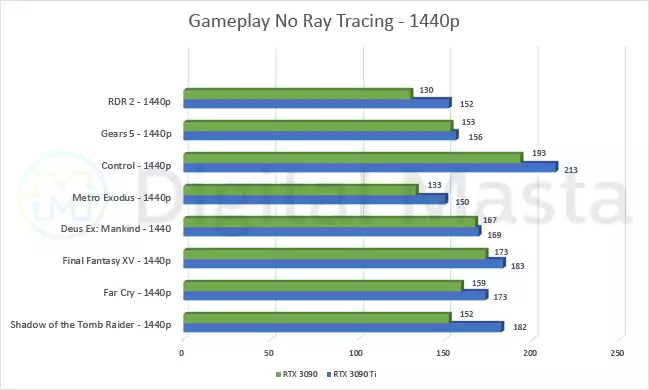
At 1440p Tomb Raider still gives 30 FPS difference in RTX 3090 Ti, just like Metro Exodus, and finally RDR 2 with 32 FPS difference.
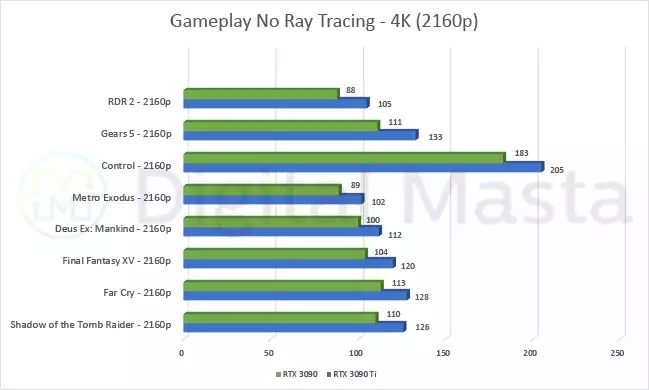
Entering 4K we see that the most important differences are 22 FPS (Control) and 16 FPS in second place. These results are a bit disappointing as the Nvidia RTX 3090 Ti was being sold as the solution to 4k gaming.
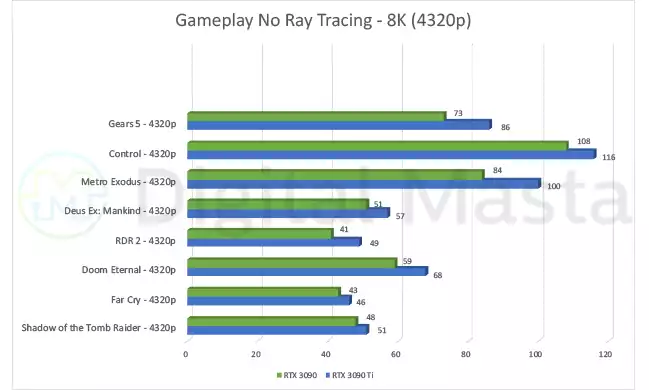
Finally in 8K we see average differences of 10 and 11 FPS. The only case where the RTX 3090 Ti excels is in Metro Exodus.
Energy consumption and temperature
The difference in power consumption of the RTX 3090 Ti compared to the RTX 3090 can reach up to a worrying 260 W. A somewhat alarming value that pushes the total consumption of our build up to 600 W. We have already seen the results in performance, and we see that on average we get between 10 to 20 additional FPS. Is this energy consumption (apart from its price) justifiable for such a benefit?
In terms of temperature, the RTX 3090 Ti has generally the same operating temperature as the RTX 3090. Both GPUs offer excellent cooling systems that allow optimal operation.
Conclusion
Needless to say, Nvidia finally managed to give a performance boost with its RTX 3090 Ti. There are currently gamers who would kill (no joke intended) for the additional 10 FPS and in this unbridled race to have the ultimate gaming computer rig that gives them the competitive advantage. Those who have the budget will surely find it worth investing in a graphics card like the Nvidia GTX 3090 Ti.
On the other hand, if we really evaluate the value of what we are purchasing, when we talk about Nvidia GTX 3090 vs GTX 3090 Ti, in general terms we are buying almost the same graphics card with a boost that honestly does not justify its cost.
This move by Nvidia can be interpreted as a way to squeeze sales of a video card that was already successful, but had enough hype by its target market to still be amazed with a new variant that only offers marginal improvements.
Update
The market evolves daily and apparently the recognition of the value of both cards didn’t go unnoticed by computer component dealers. Due to the high price of the GTX 3090 Ti, what dealers are doing now is raising the price of the GTX 3090 even more to leave an even shorter gap. This with the purpose of justifying the value of the GTX 3090 Ti. This way, if they fail to sell the GTX 3090 Ti, they will end up selling the GTX 3090 with a higher profit margin.
Please keep your eyes open and don’t overpay when you are in pursuit of your next GPU deal.
More stories like this
- Nvidia GTX 1650 vs RTX 3050 graphic cards
- Nvidia GTX 980 vs 1070 Full GPU Comparison
- NVIDIA GeForce GT 720 review
- NVIDIA GeForce GTX 1050 Ti Max-Q review
- NVIDIA Quadro FX 3800 review
- All About the Ada Lovelace Architecture technology of the GeForce RTX 40 Series